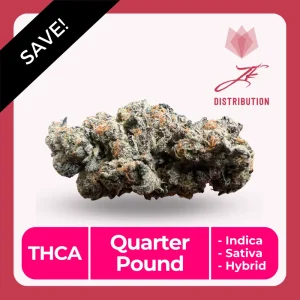THCA has been studied for years, THCP is a recent scientific discovery that has expanded what we know about the cannabinoids. Although researchers are still unmasking how these cannabinoids differ, it’s important to compare the two substances.
At JK Distro, we’ve watched interest in hemp science grow rapidly across the country. Among the compounds gaining attention are hemp-derived THCA and THCP.
As a community-driven team, we believe complex science should feel accessible, transparent, and empowering. In this guide, we’ll unpack the key differences between THCA and THCP by focusing on three essentials: potency, legality, and activation. Along the way, we’ll share how these cannabinoids fit into products you may already be curious about.
THCP is one of the newest cannabinoids in the hemp scene. Since its discovery in 2019, researchers have been studying how THCP’s unique chemical structure sets it apart from familiar compounds like hemp-derived Delta-9 THC and CBD. What they’ve found so far suggests THCP may interact with our endocannabinoid system in ways that make it a compelling focus for science, hemp innovation, and curious consumers. For many enthusiasts, discovering compounds like THCP alongside CBD is easier through a curated CBD subscription box, which brings new hemp products directly to their door.
On December 30, 2019, Italian scientists analyzing a medical cannabis strain known as FM2 made an unexpected discovery: two new phytocannabinoids called THCP and CBDP. These plant-derived compounds mimic the behavior of natural endocannabinoids.
Unlike THCA, the defining feature of THCP is its seven-atom side chain. This small structural difference carries big implications. Early research found that THCP bound to CB1 receptors up to 33 times more efficiently than hemp-derived Delta-9 THC and showed up to 10 times greater activity at CB2 receptors. Better yet, even at smaller doses, THCP was shown to be as active as Delta-9 THC.
THCP occurs naturally in cannabis hemp, though only in trace amounts. Because those concentrations are so small, most commercial THCP is produced through a process that converts other hemp-derived cannabinoids into THCP. This approach is often deemed semi-synthetic, since the result originates from natural hemp compounds but requires additional processing.
THCA is one of the most abundant compounds in raw cannabis hemp. Found naturally in cannabis, THCA plays a central role in shaping the hemp experience. Unlike hemp-derived Delta-9 THC, THCA in its natural state is non-psychoactive. However, when exposed to heat, it transforms into active Delta-9 THC.
Every cannabinoid begins somewhere, and for THCA, that story starts with CBGA. As hemp plants mature, CBGA branches off into several cannabinoid acids, one being THCA. Because it forms early and in larger amounts, THCA is found throughout raw hemp flower long before it undergoes any form of decarboxylation.
THCA stands apart because of how it changes when exposed to heat. While THCP has gained attention for its rare potency and unique side chain, THCA offers versatility. This dual identity, raw versus activated, gives hemp consumers flexibility in how they approach THCA through flower, concentrates, or infused products.
The legal landscape around hemp-derived cannabinoids can be confusing, particularly as new discoveries like THCP challenge existing frameworks. While both THCA and THCP are derived from cannabis hemp, their status under federal and state law varies. For anyone exploring these compounds, staying informed is crucial to making informed, confident, and compliant decisions.
THCA is directly tied to the legal definition of hemp under the 2018 Farm Bill. Federal law defines hemp as cannabis containing no more than 0.3% hemp-derived Delta-9 THC on a dry-weight basis. Because THCA in its raw form is non-psychoactive and doesn’t automatically count toward that Delta-9 threshold until it is decarboxylated, many hemp products rich in THCA fall under the definition of federally legal hemp.
That being said, the situation can shift depending on how states interpret hemp material. Some regulators measure total potential Delta-9 THC content, including what THCA could convert into when heated. This means THCA flower that is federally compliant may be treated differently at the state level, creating a patchwork of regulations for consumers and producers.
THCP presents a more complex case. Although it occurs naturally in hemp, the trace levels are too low for commercial production. Because of this, most THCP products are created by converting hemp-derived CBD into THCP using a “semi-synthetic” process. According to the DEA, synthetically derived tetrahydrocannabinols fall under Schedule I controlled substances, regardless of hemp origin.
However, the DEA has not issued a direct ruling on THCP, but its stance on cannabinoids like THC-O in 2023 suggests that compounds altered beyond naturally occurring levels may be at risk of classification, adding another layer of obscurity in the hemp space.
Even with federal guidelines in place, state laws ultimately shape consumer access. Many states have chosen to explicitly regulate or prohibit cannabinoids like THCP alongside Delta-8 THC and other emerging compounds. Others continue to allow THCP under broader hemp provisions, provided products meet federal Delta-9 THC limits.
For THCA, the situation is somewhat clearer. States that align with the Farm Bill definition of hemp generally permit hemp-derived THCA flower and concentrates. Still, testing methods and enforcement vary, so it remains important to confirm local rules before making a purchase or adding new hemp products to your routine.
So, which one is stronger? Well, cannabinoid strength ultimately comes down to how it interacts with your body’s endocannabinoid system. THCP and THCA share a connection to hemp’s natural chemistry, yet their molecular structures lead to very different outcomes. For hemp consumers, these differences influence how each compound shows up in products and daily routines.
Research has shown that THCP contains a seven-atom side chain, which allows it to bind more efficiently with CB1 receptors in the brain and central nervous system. Early findings suggest THCP can be up to 30 times more active at CB1 than hemp-derived Delta-9 THC. It also demonstrates stronger interaction with CB2 receptors, though the impact there is less pronounced. This elevated receptor activity is why THCP is considered one of the most potent cannabinoids discovered.
THCA takes a different path. In its raw form, it does not strongly activate CB1 or CB2 receptors, which is why it remains non-psychoactive until heated. Once exposed to heat through smoking, vaping, or cooking, THCA converts into hemp-derived Delta-9 THC. That transformation is what gives THCA products their flexibility. For example, raw flower can be blended into food without triggering the same active compounds, while decarboxylated flower delivers a stronger effect.
Compared with THCP’s efficiency at receptor binding, THCA’s potency depends largely on the consumer’s method of use. This makes it appealing for those who want more control over their experience, from raw consumption to activated formats.
For anyone exploring “THCA vs THCP,” potency is one of the most important distinctions. THCP’s strong receptor binding makes it stand out in hemp research, while THCA offers adaptability through the choice between raw and activated states.
In practice, this means THCP may appear in smaller, concentrated amounts within specialty products, whereas THCA is commonly available in flower, concentrates, and edibles. For consumers, the decision often comes down to intent: you might reach for THCA flower as part of a weekend wind-down or experiment with cooking, while THCP may attract curiosity for its rare and powerful profile.
Exploring hemp-derived cannabinoids like THCA and THCP shows how much depth there is in hemp science. THCP stands out for its strong receptor activity and rare potency, while THCA offers flexibility because of its ability to remain non-psychoactive in raw form or convert into hemp-derived Delta-9 THC once heated. Together, they highlight two different paths within the same plant, each with its own implications for potency, legality, and consumer experience.
For JK Distro community members, this comparison helps guide how hemp fits into daily routines, whether through a flower session at the end of a long day, experimenting with edibles, or exploring the latest cannabinoid research. At JK Distro, we’re committed to offering federally legal hemp products that reflect both science and care. We hope we’ve clarified some of your questions so you can continue exploring hemp products safely!
Read more:
THCA and THCP are two distinct cannabinoids found in cannabis hemp. THCA is a non-intoxicating compound naturally present in raw hemp flower. When heated, it converts into hemp-derived Delta-9 THC, which is responsible for the plant’s psychoactive effects.
On the other hand, THCP is a rare, recently discovered cannabinoid. To briefly summarize, THCA starts out non-intoxicating and needs heat to transform, while THCP is a heavy hitter that may surpass other cannabinoids.
THCA is converted into hemp-derived Delta-9 THC through a process called decarboxylation. This most often happens when you smoke, vape, or bake hemp flower or extract. The heat causes THCA to lose a carboxyl group, transforming it into psychoactive Delta-9 THC. So, if you’re enjoying raw THCA flower, you won’t feel the same effects until you apply heat.
THCA is much more widely available in hemp-derived products. You’ll find THCA-rich hemp flower, concentrates, and edibles at many retailers that source from compliant cannabis hemp. THCP, however, is rare both in nature and in products. It’s typically produced in very small amounts or synthesized in a lab for specialty products due to its scarcity.
Yes, both THCA and THCP are naturally occurring in cannabis hemp plants, though in very different amounts. THCA is one of the most abundant cannabinoids found in raw flower. THCP occurs only in trace levels, making it difficult to extract in large quantities directly from the plant. This is why most commercial THCP is produced using advanced techniques that convert other naturally occurring cannabinoids into THCP.
Most THCP on the market is semi-synthetic. While it can occur naturally in cannabis hemp, it’s usually present in such tiny concentrations that processors must convert other hemp-derived cannabinoids into THCP using chemical processes. However, because THCP is often made through processing, its legal status can sometimes fall into a gray area where state laws or specific interpretations of federal rules apply. As always, we recommend checking your local hemp laws before purchasing.
THCA by itself (in its raw form) doesn’t produce intoxicating effects. When decarboxylated, it becomes hemp-derived Delta-9 THC and delivers familiar psychoactive sensations. THCP, conversely, is reported to be far more potent than both THCA and regular Delta-9 THC. Early research indicates that THCP may result in more intense psychoactive and physical effects, though everyone’s experience will vary.
Most federally legal hemp products are made from cannabis hemp cultivars that contain only trace amounts of naturally occurring THCP. While these micro-quantities may technically be present, the concentration is so low that you’re unlikely to notice any effects from them. Products that specifically highlight THCP content typically contain lab-converted cannabinoids, ensuring there’s enough in each dose to feel.
Sources:




Support cannabis rights with a donation. Your contribution funds legal challenges, awareness campaigns, and advocacy to keep cannabis accessible and legal. Stand up for our rights and the future of cannabis in Nationwide. Click for More info on the Hemp Litigation Fund.


Are you 21 or Older?
Please verify that you are 21 years of age or older to enter this site.
NO MINORS!